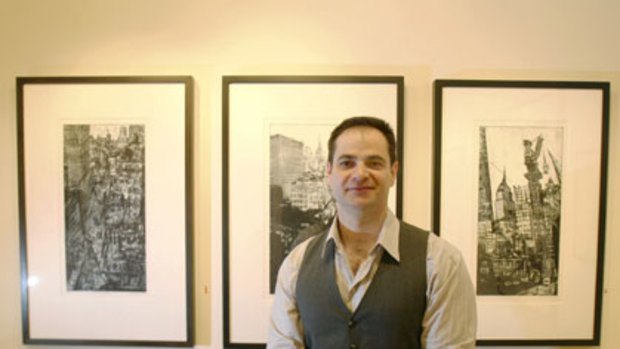By Alicia Wood
Marco Luccio sat on a Manhattan street in the snow, carving into copper and trying to blend in with a frenetic crowd.
The Australian artist has created his etchings in some of the world's grandest cities but New York proved the biggest challenge.

Urban ... some of Marco Luccio's New York works.Credit: Helen Nezdropa
''I sat there, in front of Grand Central Station, on the corner of 42nd and Vanderbilt, and scratched directly onto the copperplate. Suddenly this young rap singer starts singing about what I'm doing,'' Luccio said.
''Suddenly there is a crowd around me, full of people, it was really unnerving. In New York they really wanted to be part of it. I just had to give into it.''
Luccio, from Melbourne, had wanted to create a collection of prints inspired by New York since he saw Fritz Lang's film Metropolis as an art student.
''When I got there, it was overwhelming, it was almost an abuse to the senses,'' he said.
But he fell into a rhythm and became part of the landscape that so inspired him.
''Everyone has their own New York City in their head,'' he said. ''It's about the real and imagined as well as capturing the city.''
Cityscapes of New York is a collection of Luccio's work that opened last week at Australian Galleries.
The gallery's national director, Stuart Purves, said Luccio had made ''prints with integrity.''
''There can be a great lack of understanding about printmaking. The thing that makes an original etching is that the artist's hand has drawn the images on the plate,'' he said.
At the gallery's Roylston Street premises painter Colin Lanceley was back to open a show for the first time in three years.
The Gaudi Quartet and other lyrical digressions is a series of works that reference Lanceley's deep admiration of the Spanish architect Antoni Gaudi. ''They are just the most wonderful, sensual buildings. They are almost like sculptures,'' Lanceley said.
Gender bender
The work of fashion photographer Guy Bourdin is often charged with pushing boundaries and fetishising the female form.
At the Australian Centre of Photography, Sydney artists Techa Noble and Emma Price have pushed Bourdin's boundaries further than he could have imagined.
The artists, who go under the name The Birthday Suit, appropriated a 1976 image by Bourdin, which depicted four naked female models holding anthurium flowers over their genitals.
In their image After Guy, The Birthday Suit have used four female-to-male transgender models to recreate the image, and make a comment on modern gender roles.
''It is an open-ended image which could have a whole lot of readings,'' Noble said. ''I am interested in that body, and I think it's an interesting image that is ambiguous within the language of our practice.''
Investors' worry
Talk of finance dominated discussions at the opening of The Essential Collection at Smith and Hall gallery in Redfern.
The show features works on paper by some of Australia's most celebrated artists, such as the Archibald winners Adam Cullen and Craig Ruddy, and would naturally attract visitors looking to invest in art.
But the federal government's Cooper review of superannuation has the art world spooked. The review suggests art investment should be banned from self-managed super funds.
Gallery director Cameron Hall said his clients were becoming increasingly nervous about investing in art.
''The secondary outcome of this is there could be a flooding of the market, with fewer buyers and more sellers who are under pressure to sell in order to exit artworks from their self-managed super,'' Hall said.
Award-winning printmaker Paul Smith, who collaborated with many of the artists in the show, said his business had come to a standstill since the review was announced.
''Labor has always supported the arts but now they've virtually destroyed my business,'' Smith said.